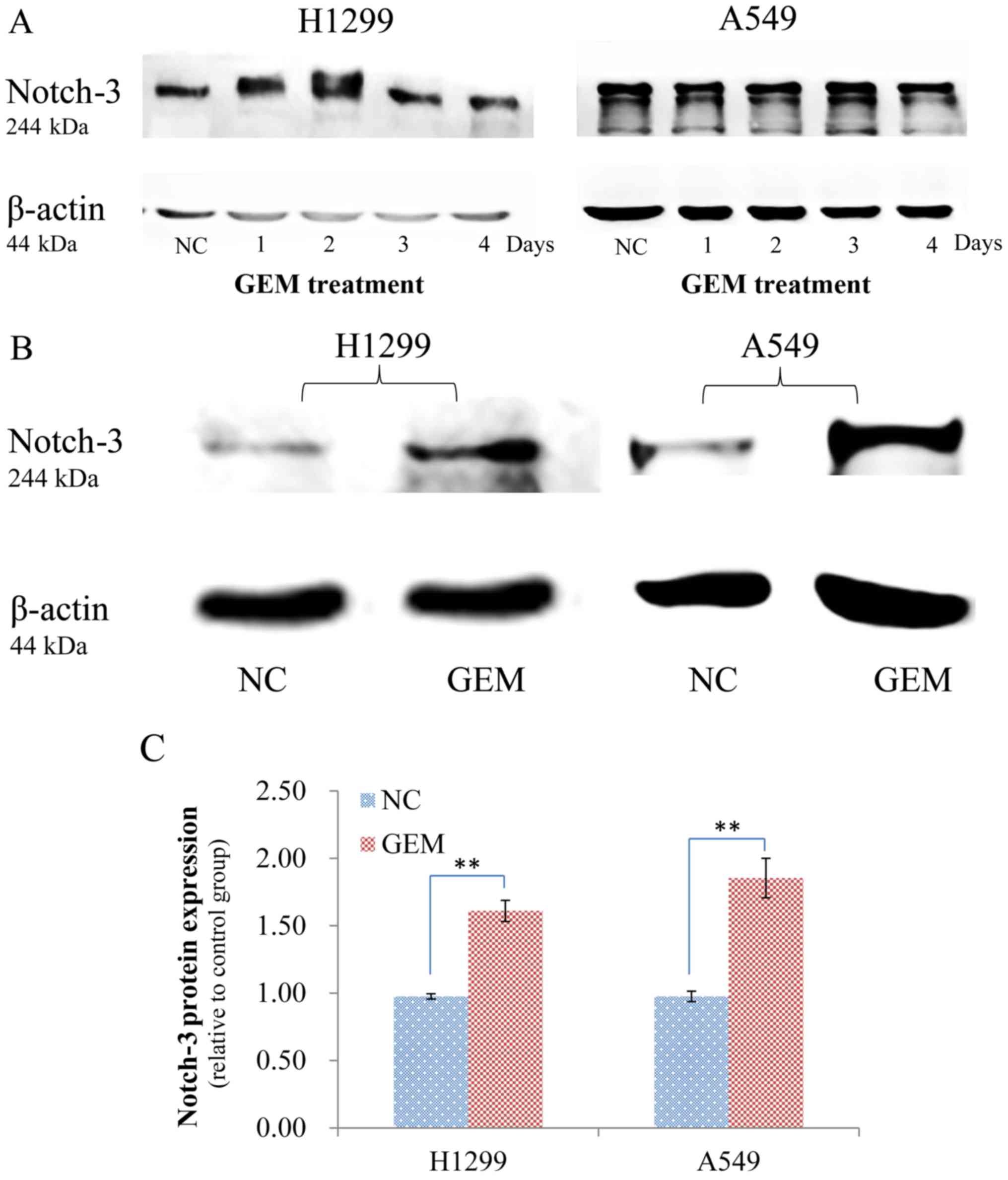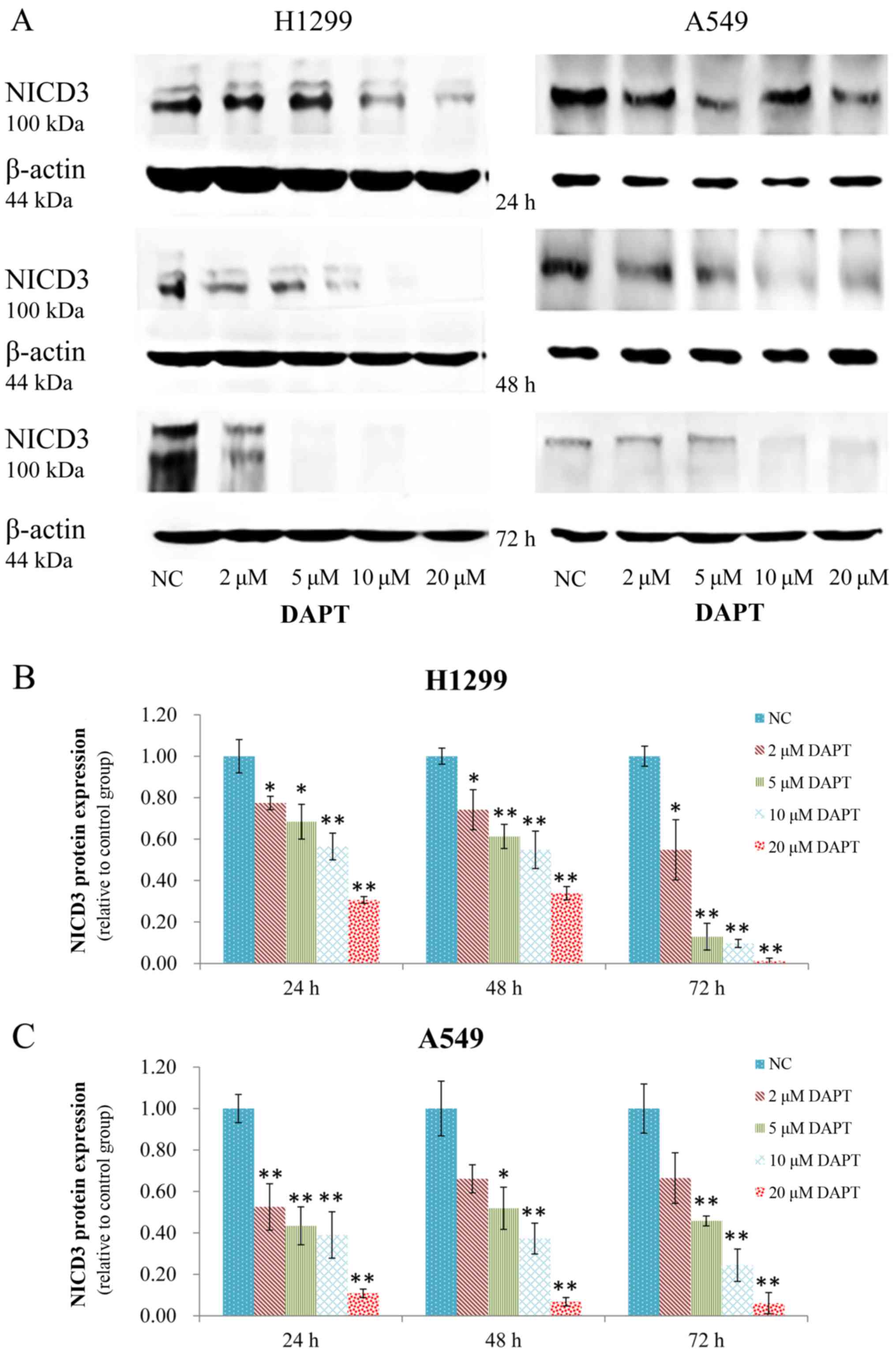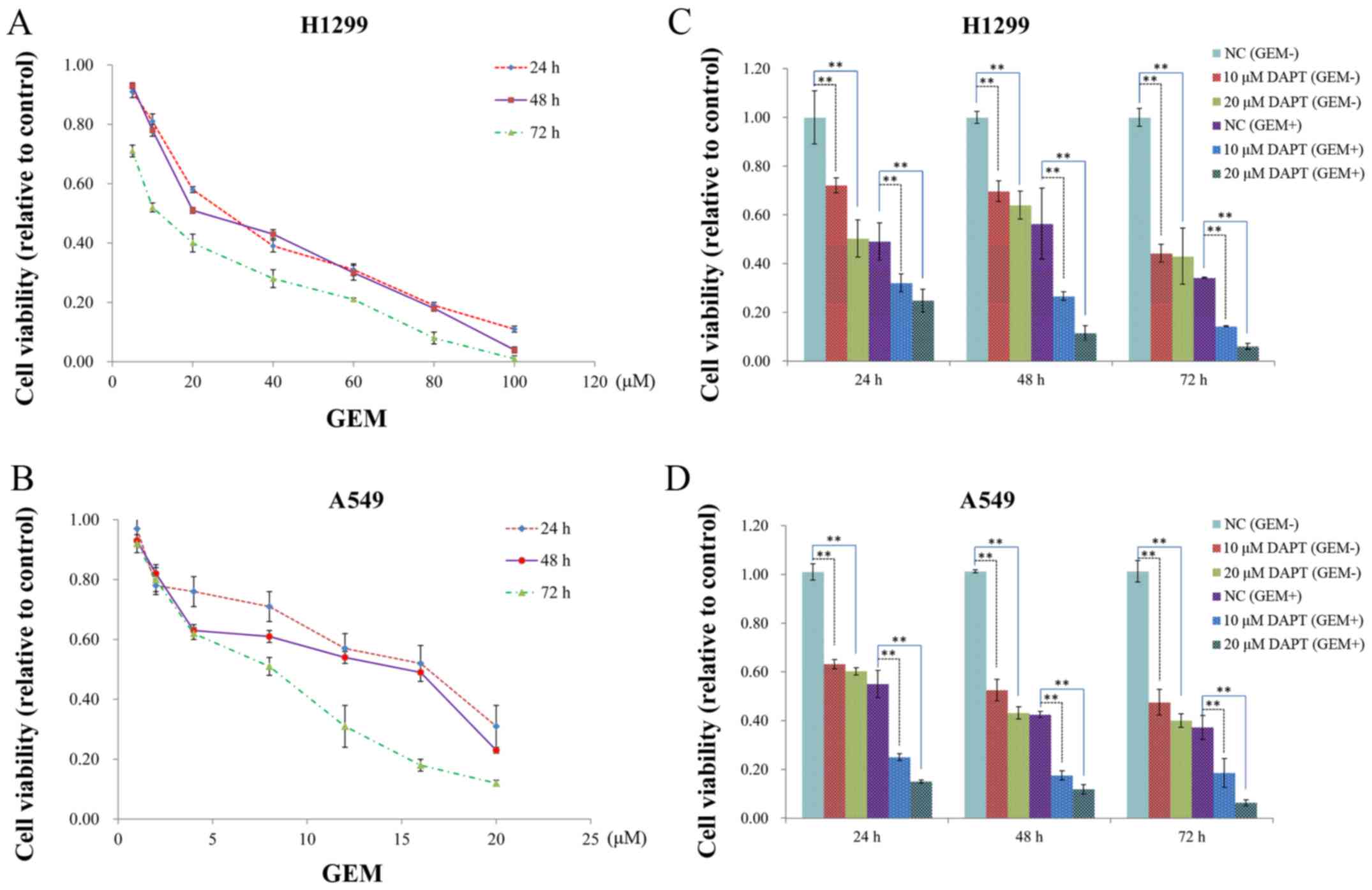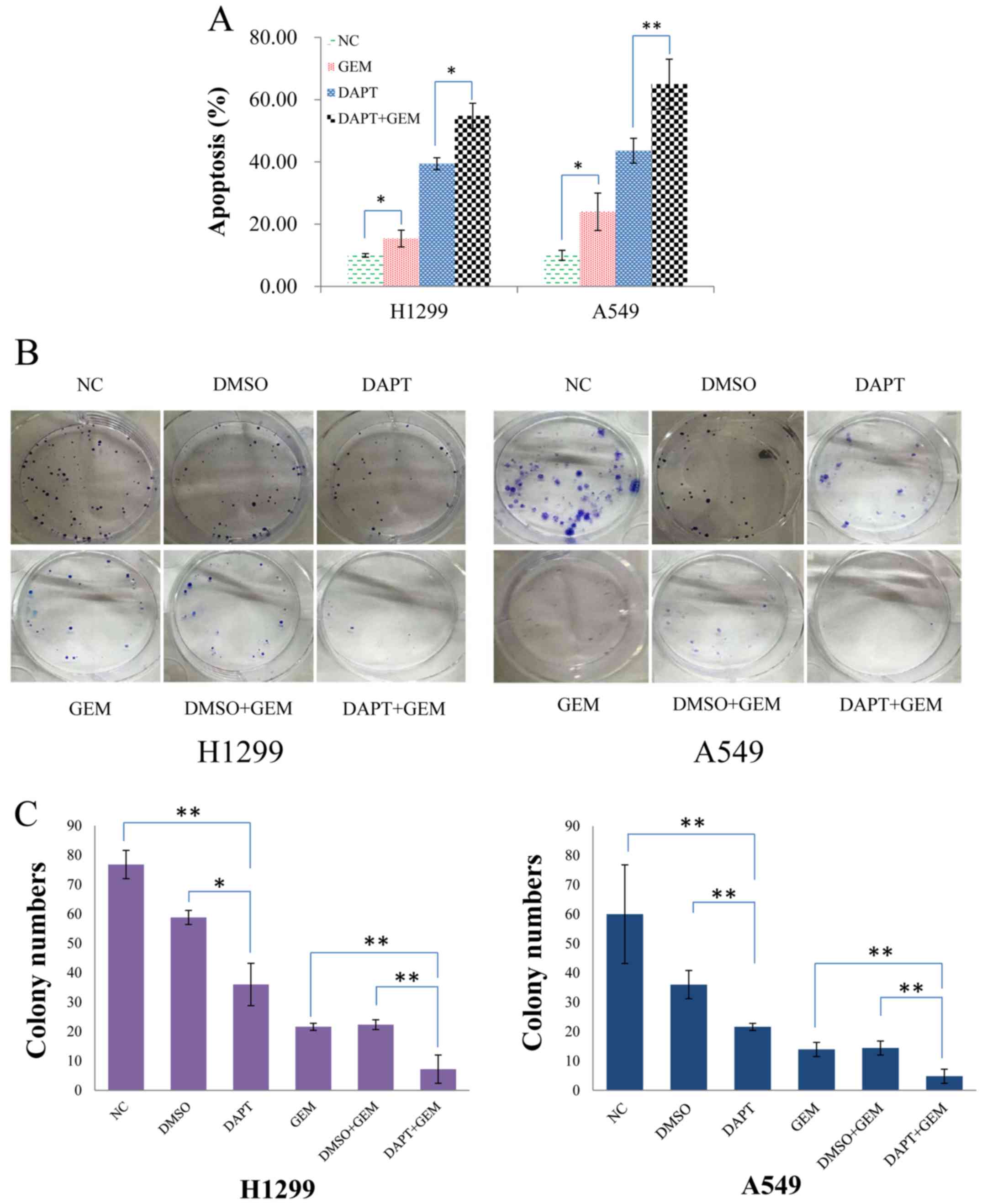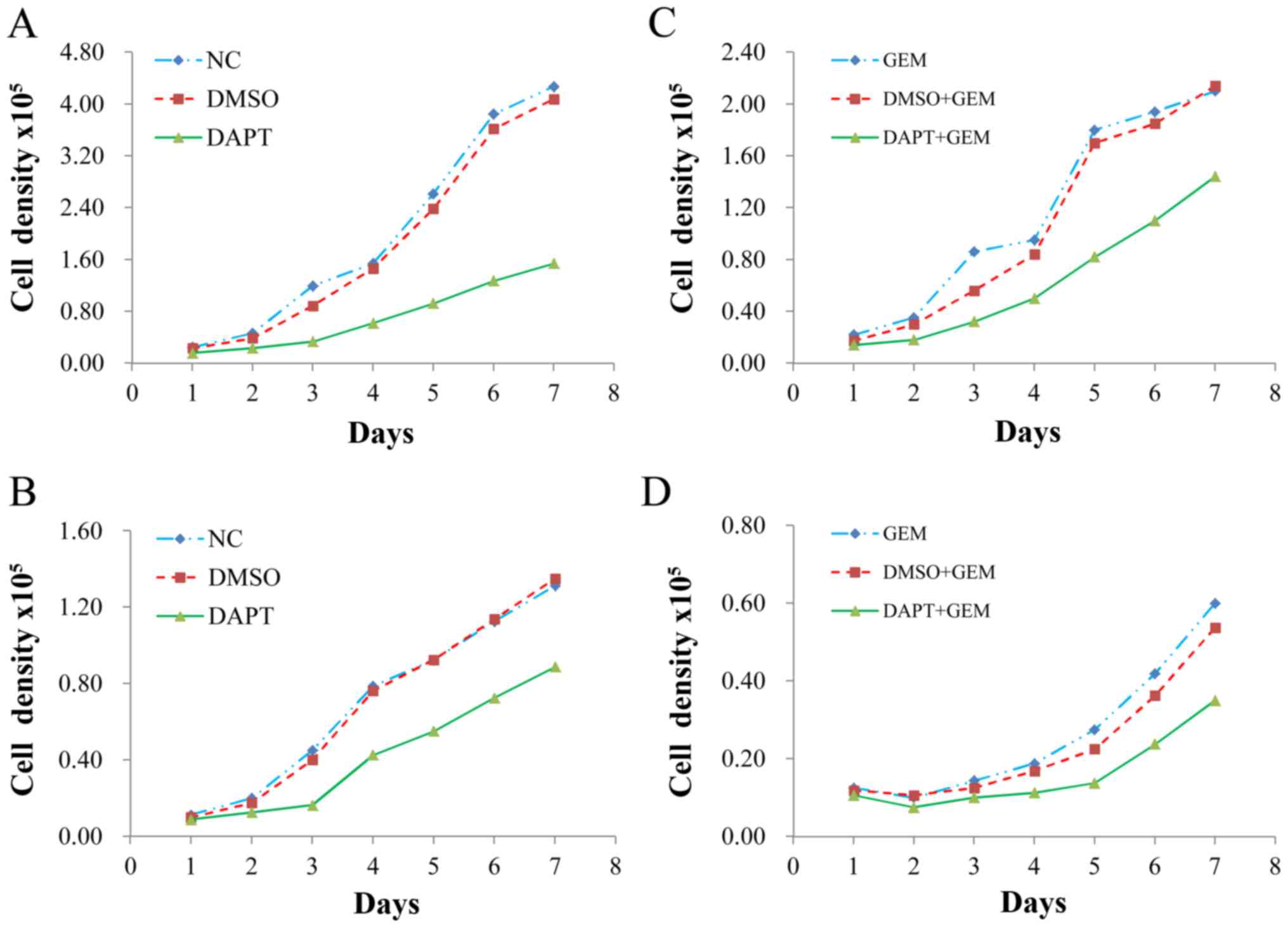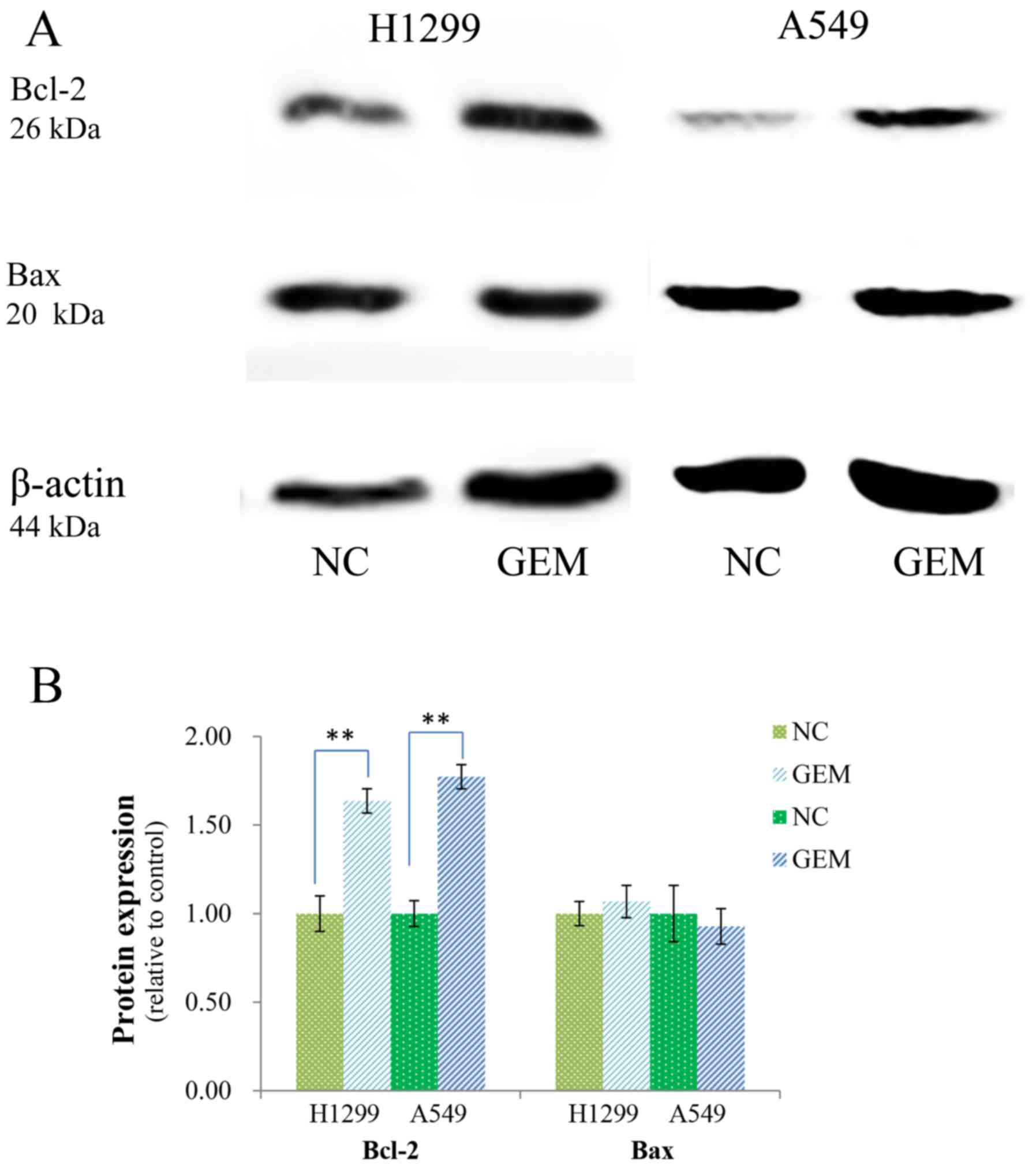|
1
|
Siegel R, Ma J, Zou Z and Jemal A: Cancer
statistics, 2014. CA Cancer J Clin. 64:9–29. 2014. View Article : Google Scholar : PubMed/NCBI
|
|
2
|
Ridge CA, McErlean AM and Ginsberg MS:
Epidemiology of lung cancer. Semin Intervent Radiol. 30:93–98.
2015. View Article : Google Scholar
|
|
3
|
D'Addario G and Felip E: ESMO Guidelines
Working Group: Non-small-cell lung cancer: ESMO clinical
recommendations for diagnosis, treatment and follow-up. Ann Oncol.
20 Suppl 4:S68–S70. 2009. View Article : Google Scholar
|
|
4
|
Neal JW, Dahlberg SE, Wakelee HA, Aisner
SC, Bowden M, Huang Y, Carbone DP, Gerstner GJ, Lerner RE, Rubin
JL, et al: Erlotinib, cabozantinib, or erlotinib plus cabozantinib
as second-line or third-line treatment of patients with EGFR
wild-type advanced non-small-cell lung cancer (ECOG-ACRIN 1512): A
randomised, controlled, open-label, multicentre, phase 2 trial.
Lancet Oncol. 17:1661–1671. 2016. View Article : Google Scholar : PubMed/NCBI
|
|
5
|
Reck M, Heigener DF, Mok T, Soria JC and
Rabe KF: Management of non-small-cell lung cancer: Recent
developments. Lancet. 382:709–719. 2013. View Article : Google Scholar : PubMed/NCBI
|
|
6
|
Wong A, Soo RA, Yong WP and Innocenti F:
Clinical pharmacology and pharmacogenetics of gemcitabine. Drug
Metab Rev. 41:77–88. 2009. View Article : Google Scholar : PubMed/NCBI
|
|
7
|
Dyawanapelly S, Kumar A and Chourasia MK:
Lessons learned from gemcitabine: Impact of therapeutic carrier
systems and gemcitabine's drug conjugates on cancer therapy. Crit
Rev Ther Drug Carrier Syst. 34:63–96. 2017. View Article : Google Scholar : PubMed/NCBI
|
|
8
|
Nakano Y, Tanno S, Koizumi K, Nishikawa T,
Nakamura K, Minoguchi M, Izawa T, Mizukami Y, Okumura T and Kohgo
Y: Gemcitabine chemoresistance and molecular markers associated
with gemcitabine transport and metabolism in human pancreatic
cancer cells. Br J Cancer. 96:457–463. 2007. View Article : Google Scholar : PubMed/NCBI
|
|
9
|
Vandana M and Sahoo SK: Synergistic
activity of combination therapy with PEGylated pemetrexed and
gemcitabine for an effective cancer treatment. Eur J Pharm
Biopharma. 94:83–93. 2015. View Article : Google Scholar
|
|
10
|
D'Amato G, Luxán G and de la Pompa JL:
Notch signalling in ventricular chamber development and
cardiomyopathy. FEBS J. 283:4223–4237. 2016. View Article : Google Scholar : PubMed/NCBI
|
|
11
|
Takebe N, Nguyen D and Yang SX: Targeting
notch signaling pathway in cancer: Clinical development advances
and challenges. Pharmacol Ther. 141:140–149. 2014. View Article : Google Scholar : PubMed/NCBI
|
|
12
|
Dang TP, Gazdar AF, Virmani AK, Sepetavec
T, Hande KR, Minna JD, Roberts JR and Carbone DP: Chromosome 19
translocation, overexpression of Notch-3, and human lung cancer. J
Natl Cancer Inst. 92:1355–1357. 2000. View Article : Google Scholar : PubMed/NCBI
|
|
13
|
Ye YZ, Zhang ZH, Fan XY, Xu XL, Chen ML,
Chang BW and Zhang YB: Notch-3 overexpression associates with poor
prognosis in human non-small-cell lung cancer. Med Oncol.
30:5952013. View Article : Google Scholar : PubMed/NCBI
|
|
14
|
Lin L, Mernaugh R, Yi F, Blum D, Carbone
DP and Dang TP: Targeting specific regions of the Notch-3
ligand-binding domain induces apoptosis and inhibits tumor growth
in lung cancer. Cancer Res. 70:632–638. 2010. View Article : Google Scholar : PubMed/NCBI
|
|
15
|
Shi C, Qian J, Ma M, Zhang Y and Han B:
Notch 3 protein, not its gene polymorphism, is associated with the
chemotherapy response and prognosis of advanced NSCLC patients.
Cell Physiol Biochem. 34:743–752. 2014. View Article : Google Scholar : PubMed/NCBI
|
|
16
|
Rahman MT, Nakayama K, Rahman M, Katagiri
H, Katagiri A, Ishibashi T, Ishikawa M, Iida K, Nakayama S, Otsuki
Y and Miyazaki K: Notch-3 overexpression as potential therapeutic
target in advanced stage chemoresistant ovarian cancer. Am J Clin
Pathol. 138:535–544. 2012. View Article : Google Scholar : PubMed/NCBI
|
|
17
|
Groeneweg JW, DiGloria CM, Yuan J,
Richardson WS, Growdon WB, Sathyanarayanan S, Foster R and Rueda
BR: Inhibition of notch signaling in combination with Paclitaxel
reduces platinum-resistant ovarian tumor growth. Front Oncol.
4:1712014. View Article : Google Scholar : PubMed/NCBI
|
|
18
|
Groth C and Fortini ME: Therapeutic
approaches to modulating notch signaling: Current challenges and
future prospects. Semin Cell Dev Biol. 23:465–472. 2012. View Article : Google Scholar : PubMed/NCBI
|
|
19
|
Konishi J, Kawaguchi KS, Vo H, Haruki N,
Gonzalez A, Carbone DP and Dang TP: Gamma-secretase inhibitor
prevents Notch-3 activation and reduces proliferation in human lung
cancers. Cancer Res. 67:8051–8057. 2007. View Article : Google Scholar : PubMed/NCBI
|
|
20
|
Patrad E, Niapour A, Farassati F and Amani
M: Combination treatment of all-trans retinoic acid (ATRA) and
γ-secretase inhibitor (DAPT) cause growth inhibition and apoptosis
induction in the human gastric cancer cell line. Cytotechnology.
70:865–877. 2018. View Article : Google Scholar : PubMed/NCBI
|
|
21
|
Jiang J, Miao Y, Xiao S, Zhang Z and Hu Z:
DAPT in the control of human hair follicle stem cell proliferation
and differentiation. Postepy Dermatol Alergol. 31:201–206. 2014.
View Article : Google Scholar : PubMed/NCBI
|
|
22
|
Tammam J, Ware C, Efferson C, O'Neil J,
Rao S, Qu X, Gorenstein J, Angagaw M, Kim H, Kenific C, et al:
Down-regulation of the Notch pathway mediated by a gamma-secretase
inhibitor induces anti-tumour effects in mouse models of T-cell
leukaemia. Br J Pharmacol. 158:1183–1195. 2009. View Article : Google Scholar : PubMed/NCBI
|
|
23
|
Kang H, Jeong JY, Song JY, Kim TH, Kim G,
Huh JH, Kwon AY, Jung SG and An HJ: Notch-3-specific inhibition
using sirna knockdown or gsi sensitizes paclitaxel-resistant
ovarian cancer cells. Mol Carcinog. 55:1196–1209. 2016. View Article : Google Scholar : PubMed/NCBI
|
|
24
|
Tolcher AW, Messersmith WA, Mikulski SM,
Papadopoulos KP, Kwak EL, Gibbon DG, Patnaik A, Falchook GS, Dasari
A, Shapiro GI, et al: Phase I study of RO4929097, a gamma secretase
inhibitor of Notch signaling, in patients with refractory
metastatic or locally advanced solid tumors. J Clin Oncol.
30:2348–2353. 2012. View Article : Google Scholar : PubMed/NCBI
|
|
25
|
Roy M, Pear WS and Aster JC: The
multifaceted role of Notch in cancer. Curr Opin Genet Dev.
17:52–59. 2007. View Article : Google Scholar : PubMed/NCBI
|
|
26
|
Yuan X, Wu H, Xu H, Xiong H, Chu Q, Yu S,
Wu GS and Wu K: Notch signaling: An emerging therapeutic target for
cancer treatment. Cancer Lett. 369:20–27. 2015. View Article : Google Scholar : PubMed/NCBI
|
|
27
|
Cheng B, Cai XJ, Chen LY, Wang Z, Weng L
and Li QL: Predictors and impact of cytotoxic second-line
chemotherapy for stage IIIa-IV nonsmall lung cancer patients in
China: A retrospective institution analysis of 132 patients. J
Cancer Res There. 1 Suppl 1:C84–C88. 2015.
|
|
28
|
Lin JJ and Shaw AT: Resisting resistance:
Targeted therapies in lung cancer. Trends Cancer. 2:350–364. 2016.
View Article : Google Scholar : PubMed/NCBI
|
|
29
|
Eto K, Kawakami H, Kuwatani M, Kudo T, Abe
Y, Kawahata S, Takasawa A, Fukuoka M, Matsuno Y, Asaka M, et al:
Human equilibrative nucleoside transporter 1 and Notch-3 can
predict gemcitabine effects in patients with unresectable
pancreatic cancer. Br J Cancer. 108:1488–1494. 2013. View Article : Google Scholar : PubMed/NCBI
|
|
30
|
Tokunaga Y, Liu D, Nakano J, Zhang X, Nii
K, Go T, Huang CL and Yokomise H: Potent effect of adenoviral
vector expressing short hairpin RNA targeting ribonucleotide
reductase large subunit M1 on cell viability and chemotherapeutic
sensitivity to gemcitabine in non-small cell lung cancer cells. Eur
J Cancer. 51:2480–2489. 2015. View Article : Google Scholar : PubMed/NCBI
|
|
31
|
Li B, Yao Z, Wan Y and Lin D:
Overexpression of OCT4 is associated with gefitinib resistance in
non-small cell lung cancer. Oncotarget. 7:77342–77347.
2016.PubMed/NCBI
|
|
32
|
Park JT, Chen X, Trope CG, Davidson B,
Shih IeM and Wang TL: Notch-3 overexpression is related to the
recurrence of ovarian cancer and confers resistance to carboplatin.
Am J Pathol. 177:1087–1094. 2010. View Article : Google Scholar : PubMed/NCBI
|
|
33
|
McAuliffe SM, Morgan SL, Wyant GA, Tran
LT, Muto KW, Chen YS, Chin KT, Partridge JC, Poole BB, Cheng KH, et
al: Targeting Notch, a key pathway for ovarian cancer stem cells,
sensitizes tumors to platinum therapy. Proc Natl Acad Sci USA.
109:E2939–E2948. 2012. View Article : Google Scholar : PubMed/NCBI
|
|
34
|
Aoki S, Mizuma M, Takahashi Y, Haji Y,
Okada R, Abe T, Karasawa H, Tamai K, Okada T, Morikawa T, et al:
Aberrant activation of Notch signaling in extrahepatic
cholangiocarcinoma: Clinicopathological features and therapeutic
potential for cancer stem cell-like properties. BMC Cancer.
16:8542016. View Article : Google Scholar : PubMed/NCBI
|
|
35
|
Du X, Zhao YP, Zhang TP, Zhou L, Chen G,
Wang TX, You L and Shu H: Arch Med Res. Alteration of the intrinsic
apoptosis pathway is involved in Notch-induced chemoresistance to
gemcitabine in pancreatic cancer. Arch Med Res. 45:15–20. 2014.
View Article : Google Scholar : PubMed/NCBI
|
|
36
|
Yao J and Qian C: Inhibition of Notch-3
enhances sensitivity to gemcitabine in pancreatic cancer through an
inactivation of PI3K/Akt-dependent pathway. Med oncol.
27:1017–1022. 2010. View Article : Google Scholar : PubMed/NCBI
|
|
37
|
Gross A: BCL-2 family proteins as
regulators of mitochondria metabolism. Biochim Biophys Acta.
1857:1243–1246. 2016. View Article : Google Scholar : PubMed/NCBI
|
|
38
|
Jia SS, Xi GP, Zhang M, Chen YB, Lei B,
Dong XS and Yang YM: Induction of apoptosis by D-limonene is
mediated by inactivation of Akt in LS174T human colon cancer cells.
Oncol Rep. 29:349–354. 2013. View Article : Google Scholar : PubMed/NCBI
|
|
39
|
Zhang HB, Lu P, Guo QY, Zhang ZH and Meng
XY: Baicalein induces apoptosis in esophageal squamous cell
carcinoma cells through modulation of the PI3K/Akt pathway. Oncol
Lett. 5:722–728. 2013. View Article : Google Scholar : PubMed/NCBI
|
|
40
|
Yang X, Wang S, Mu Y and Zheng Y:
Schisandrin B inhibits cell proliferation and induces apoptosis in
human cholangiocarcinoma cells. Oncol Rep. 36:1799–1806. 2016.
View Article : Google Scholar : PubMed/NCBI
|
|
41
|
Ferreira Cda S, Maganhin CC, Rdos Simões
S, Girão MJ, Baracat EC and Soares JM Jr: Melatonin: Cell death
modulator. Rev Assoc Med Bras. 56:715–718. 2010.(In Portuguese).
View Article : Google Scholar : PubMed/NCBI
|



